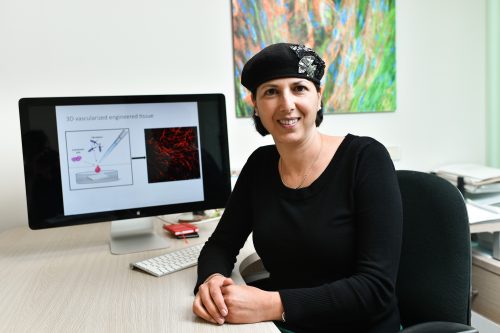The field of tissue engineering is developing at a tremendous speed, but the scientific community is still facing some complex challenges that it poses. One of them is the creation of a branched vascular network and its maturation during the growth stage in the laboratory

Researchers at the Faculty of Biomedical Engineering at the Technion have shown that a prolonged growth period of tissues for transplantation in the laboratory increases by hundreds of percent the chances of their absorption in the body. The research published in the journal of the American Academy of Sciences PNAS was conducted under the guidance of the dean of the faculty Prof. Shulamit Levenberg. The research was led by doctoral student Shahar Ben-Shaul and her fellow doctoral students Shira Landau and Uri Mardler participated in it.
Tissue transplantation is an accepted method of treating organs damaged by trauma or disease. In most cases, the transplanted tissue is taken from a donor (allograft) or from the patient himself (autograft). A transplant that originates from the patient himself is usually preferable, as it does not lead to rejection of the transplant by the patient's immune system. However, extracting the tissue from the patient is not always possible, and when it is performed, it causes him damage in another area of his body.
This is the background for the development of the field of tissue engineering. This approach aims to provide the patient with tissues engineered in the laboratory in a controlled manner. In this process, a tissue intended for transplantation is created in the laboratory. After it is implanted in the meter organ
It unites with him and repairs the damaged tissue.
The field of tissue engineering is developing at a tremendous speed, but the scientific community is still facing some complex challenges that it poses. One of them is the creation of a branched vascular network and its maturation during the growth stage in the laboratory. Such a network is essential because without it, the transplanted tissue will not receive the food and oxygen it needs after being transplanted.
Prof. Levenberg is a world-renowned expert in tissue engineering. Since her post-doctorate at MIT she has been developing original systems for growing XNUMXD biological tissues intended for transplantation. On the biodegradable XNUMXD polymeric scaffolds she developed, she sows, along with the tissue cells, endothelial cells and support cells essential for the development of blood vessels. In this way, it constantly improves the blood vessel networks in the tissues intended for transplantation. In a series of studies she conducted in recent years, she discovered that the cyclical stretching of the tissue in the laboratory also contributes to the good growth of the blood vessels within it.
In the current study, published in the journal PNAS, the influence of another aspect of the growth of the tissue in the laboratory was examined - the maturity of the tissue at the stage of transplantation. The different tissues that have been examined now were grown under exactly the same conditions, except for the duration of their growth in the laboratory before transplantation; Some of the tissues were transplanted after a day in the laboratory, some after a week and some after two weeks.
The results were dramatic and clear: the tissues transplanted after the longest period of time - two weeks - were absorbed quickly and with enormous success compared to the other tissues; The network connection (anastomosis) between the blood vessels of the transplanted tissue and the target organ was accelerated 6 times or more, that is, by hundreds of percent. This means that the absorption time of the implant was much faster. Furthermore, the transplantation of the mature tissues (two weeks old) significantly reduced the formation of dangerous blood clots in the blood vessels inside. Shahar Ben-Shaul hopes that following the current study, which was conducted in mice, additional preclinical studies will be carried out that will lead to the application of the research conclusions in humans.
The research was supported by the European Union (FP7 program) and by the Centers of Excellence program (I-CORE) of the Planning and Budgeting Committee (VAT).
